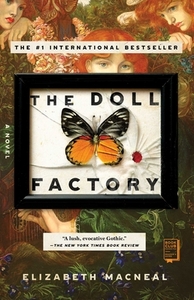Take a photo of a barcode or cover
challenging
dark
emotional
mysterious
tense
slow-paced
Plot or Character Driven:
A mix
Strong character development:
Yes
Loveable characters:
No
Diverse cast of characters:
No
Flaws of characters a main focus:
Complicated
I wanted so much to like this as it had so many elements I like – the Pre-Raphaelite Brotherhood, gothic themes, stories of obsession and beauty, invocative Victorian settings and unusual Victorian jobs – and in the end I was so disappointed that I almost didn’t finish which I hardly ever do. The pacing was incredibly uneven – it’s slow to build at first, movement happens and then we seem to spend a long time with things churning along without further progression until the climax of the book hits and then we spend more time dwelling in that with little movement or development in the plot/characters until the abrupt, ambiguous ending arrives.
The characters are undeveloped and often they and their world felt very much like cliches. The beautiful ingénue who wants a better life, cunningly armed with an interest to make her seem interesting. The louche, rebellious artist with a heart of gold. The evil shopkeeper who abuses her staff. The judgemental, puritanical Victorian parents and sister. The adorable and tragic street urchin. Missing teeth, diseases, murder, people run over by carts. Social inequality. Saucy prostitutes. Everyone’s a prude except the ones who are scandalously disreputable. The psychopath villain. Grot is laid on with a trowel – I nearly gave up when I found myself reading a description of the street urchin doing a poo (nor is this the last of the scatological mentions), not to mention the descriptions of dead animals and taxidermy (not a good read for anyone sensitive to that). And then there’s the grimdark tone – I say “grimdark” because that to me implies a sort of shallow dark themes. I like dark themes, I don’t like something where they feel really tacked on for an author to show how mature and daring they are or where, in this case, the narrative with its adorable street urchins and other Victorian cliches doesn’t seem to fit into it – or, at least, it doesn’t fit in when the author arbitrarily kills off characters in a split second and then spends no more time on it. Adorable street urchin just got horrifically killed? Who cares, we need to spend endless chapters with the ingenue in a cellar, including scenes where she thinks about how she just soiled herself! See what I mean about scatological mentions?
I said to myself, “it’s a bad sign that the character I feel is best drawn out is the psychopath, isn’t it?” And he was the best developed of the main characters. I’d almost give Macneal a cookie for how human and, at times, pathetically sympathetic he was. Except he made the other characters look so flat by comparison.
The characters are undeveloped and often they and their world felt very much like cliches. The beautiful ingénue who wants a better life, cunningly armed with an interest to make her seem interesting. The louche, rebellious artist with a heart of gold. The evil shopkeeper who abuses her staff. The judgemental, puritanical Victorian parents and sister. The adorable and tragic street urchin. Missing teeth, diseases, murder, people run over by carts. Social inequality. Saucy prostitutes. Everyone’s a prude except the ones who are scandalously disreputable. The psychopath villain. Grot is laid on with a trowel – I nearly gave up when I found myself reading a description of the street urchin doing a poo (nor is this the last of the scatological mentions), not to mention the descriptions of dead animals and taxidermy (not a good read for anyone sensitive to that). And then there’s the grimdark tone – I say “grimdark” because that to me implies a sort of shallow dark themes. I like dark themes, I don’t like something where they feel really tacked on for an author to show how mature and daring they are or where, in this case, the narrative with its adorable street urchins and other Victorian cliches doesn’t seem to fit into it – or, at least, it doesn’t fit in when the author arbitrarily kills off characters in a split second and then spends no more time on it. Adorable street urchin just got horrifically killed? Who cares, we need to spend endless chapters with the ingenue in a cellar, including scenes where she thinks about how she just soiled herself! See what I mean about scatological mentions?
I said to myself, “it’s a bad sign that the character I feel is best drawn out is the psychopath, isn’t it?” And he was the best developed of the main characters. I’d almost give Macneal a cookie for how human and, at times, pathetically sympathetic he was. Except he made the other characters look so flat by comparison.
What a slog. I should’ve DNFed it but I was hoping it’d pick up speed. Alas, it only picked up in the last 40 minutes or so. The rest was a pretentious bore.
I think people who enjoy or study the Victorian period would enjoy this. The details of the setting and the culture are spot on from what I remember from my MA. The author clearly did her research. I just found the story so dull and not at all spooky or creepy.
So, points for building an immersive world.
I think people who enjoy or study the Victorian period would enjoy this. The details of the setting and the culture are spot on from what I remember from my MA. The author clearly did her research. I just found the story so dull and not at all spooky or creepy.
So, points for building an immersive world.
dark
medium-paced
dark
emotional
sad
slow-paced
Plot or Character Driven:
Plot
Strong character development:
No
Loveable characters:
Complicated
Diverse cast of characters:
No
Flaws of characters a main focus:
Yes
dark
emotional
hopeful
tense
medium-paced
dark
emotional
mysterious
sad
tense
slow-paced
Plot or Character Driven:
Character
Strong character development:
Yes
Loveable characters:
No
Diverse cast of characters:
No
Flaws of characters a main focus:
Complicated
This book was started at 3.75, and then i talked to my sister, then it was at a 3, and now it's a 2.5 after talking to Donna. This ending wasn't satisfying. It's vibes only. Interesting story from top down, atmosphere was good. The love story was kind of cute, but definitely not long term. Wouldn't recc, unless you're looking for a particular kind of thing
Rounding it up from a 4.5+
I was wrong! I was in horrid anticipation for a depressing, no escape type of ending. But that last chapter, a review of Iris's painting, reveals so much in just a few short pages. I generally don't read suspenseful books, it gives me to much anxiety and I did get that reading this (like my jaw is sore from clenching it for the last 20% of the book); I definitely don't regret reading because I sooo enjoyed reading this.
I was wrong! I was in horrid anticipation for a depressing, no escape type of ending. But that last chapter, a review of Iris's painting, reveals so much in just a few short pages. I generally don't read suspenseful books, it gives me to much anxiety and I did get that reading this (like my jaw is sore from clenching it for the last 20% of the book); I definitely don't regret reading because I sooo enjoyed reading this.
Un romanzo vittoriano abbastanza insolito, gotico ed inquietante.
Ambientazione nella Londra vittoriana molto ben fatta, onestamente essendo il terzo romanzo sui preraffaeliti
Che leggo avrei fatto a meno della loro “presenza”, non so perché non mi risultano mai simpatici ( nemmeno nei precedenti romanzi : Effie e Lizzie entrambi dedicati a due muse dei preraffaeliti )Inoltre il romanzo sarebbe stato perfettamente in piedi senza la presenza di nomi famosi dell’arte.
La vera parte forte del romanzo è infatti la caratterizzazione dell’ossessione malata intorno al quale ruota tutta la vicenda. Fatta incredibilmente bene, realistica, angosciante al punto di dover tirare un respiro in alcune parti del romanzo. C’è molta violenza, verso animali e verso persone, e morti terribili che fanno male.
Se il primo terzo del romanzo è eccessivamente lento si riscatta nella seconda parte dove la storia finalmente tira fuori tutto il suo potenziale.
Ambientazione nella Londra vittoriana molto ben fatta, onestamente essendo il terzo romanzo sui preraffaeliti
Che leggo avrei fatto a meno della loro “presenza”, non so perché non mi risultano mai simpatici ( nemmeno nei precedenti romanzi : Effie e Lizzie entrambi dedicati a due muse dei preraffaeliti )Inoltre il romanzo sarebbe stato perfettamente in piedi senza la presenza di nomi famosi dell’arte.
La vera parte forte del romanzo è infatti la caratterizzazione dell’ossessione malata intorno al quale ruota tutta la vicenda. Fatta incredibilmente bene, realistica, angosciante al punto di dover tirare un respiro in alcune parti del romanzo. C’è molta violenza, verso animali e verso persone, e morti terribili che fanno male.
Se il primo terzo del romanzo è eccessivamente lento si riscatta nella seconda parte dove la storia finalmente tira fuori tutto il suo potenziale.






